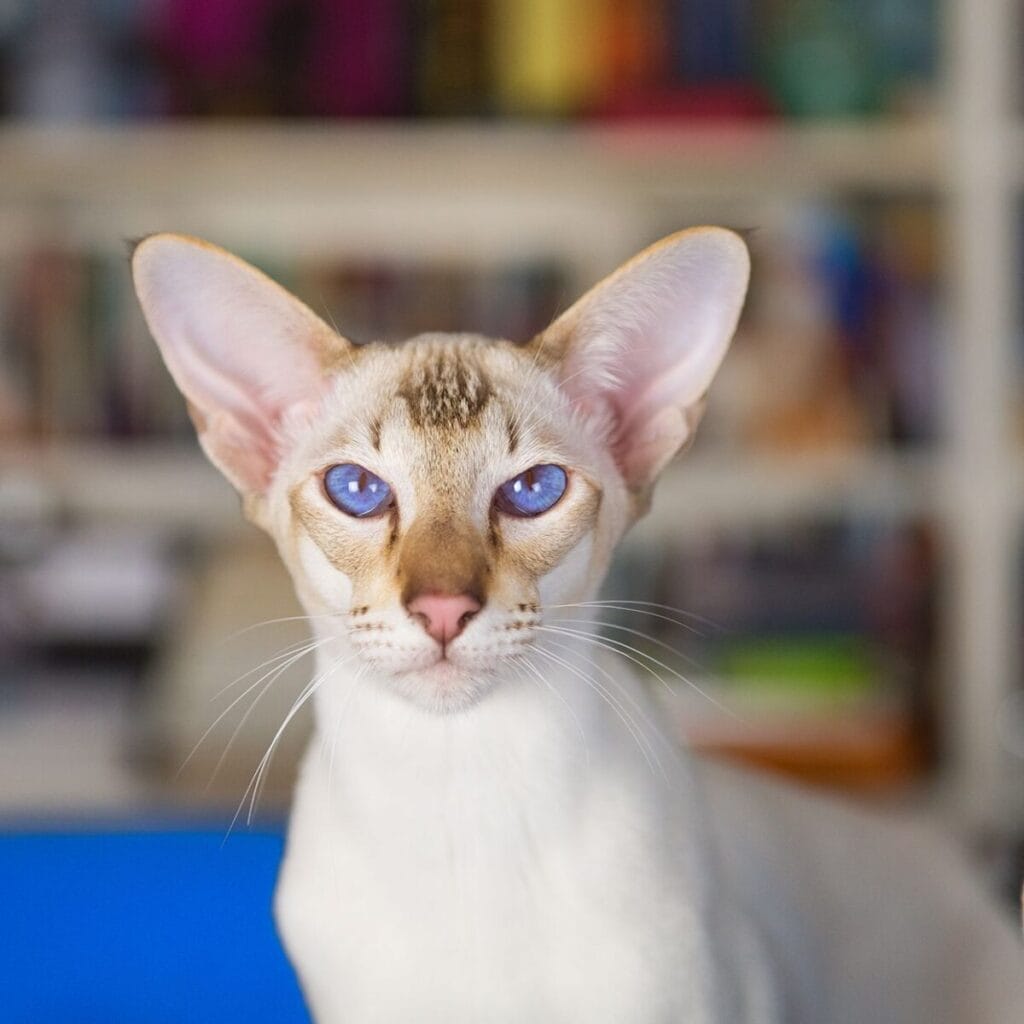The Oriental bicolor cat is a variety of the Oriental breed featuring two distinct coat colors, often with a colorpoint pattern. They originated as crosses between Siamese and other shorthaired cats to introduce new colors while retaining personality.
Introduction The Oriental Bicolor Cat Breed
The Oriental bicolor is a variety of the Oriental breed of cats featuring a colorpoint coat pattern with two distinct colors. They originated as crosses between Siamese and shorthaired cats like American Shorthairs and Russian Blues to introduce new coat colors to the Siamese while retaining their personality. The International Cat Association recognizes over 600 color varieties of the Oriental breed.

Bicolors exhibit a colorpoint pattern where the cooler areas of the body are lighter in color while the warmer areas are darker. Their bodies are one color while the face, legs, tail, and ears are a second contrasting color. Popular combinations include chocolate and seal, blue and lilac, red and cream.
Oriental bicolors have a wedge-shaped head and large ears in proportion to their large almond-shaped eyes that give them an elegant yet inquisitive appearance. They are medium-sized, long, and tubular-bodied with long tapering tails. Their short, fine, glossy coat has almost no undercoat.
Family Affection: ⭐⭐⭐⭐⭐
Shedding: ⭐⭐
Health: ⭐⭐⭐
Playfulness: ⭐⭐⭐⭐⭐
Vocalization: ⭐⭐⭐
Kid Friendly: ⭐⭐⭐⭐
Stranger Friendly: ⭐⭐⭐
Grooming: ⭐⭐⭐⭐⭐
Intelligence: ⭐⭐⭐⭐
Pet Friendly: ⭐⭐⭐
- Appearance: Wedge-shaped head, large upright ears, almond-shaped eyes, long tubular body, fine glossy coat, colorpoint pattern in two colors
- Characteristics: Affectionate, attached to owners, playful, intelligent, vocal
- Popularity: Gaining popularity for their striking coats and personalities
- Temperament: Active, playful, intelligent, people-oriented
- Lifespan: 8-15 years
- Coat Color: Colorpoint pattern in two distinct colors like chocolate and seal
Oriental bicolors are considered a mixed breed originating from Siamese and other shorthaired breeds. Common mixes include Siamese, Russian Blue, American Shorthair.
How to Care for an Oriental Bicolor Cat
Food:
- Quality cat food high in protein: Necessary for healthy muscles and organs Canned food: Provides moisture to support urinary tract health
- Treats: Reward good behavior and build bond
- Environment: Scratching posts and cat trees: Allows natural scratching behavior to preserve furniture Cat toys: Keeps them stimulated and entertained Sunny window perches: Lets them satisfy their curiosity

Grooming:
- Weekly brushing: Reduces shedding and hairballs Nail trimming monthly: Prevents scratches and discomfort Checking ears and teeth weekly: Essential for health
- Care Methods: Give them affection and playtime daily to enrich the bond with your Oriental bicolor
How to Adopt/Buy an Oriental Bicolor Cat
- Locations of Popularity: Popular as pedigreed cats in North America, Europe, and Australia
- Average Price: $400 to $600 USD
- Adoption/Rescue Groups: Oriental Cat Association Rescue, Oriental Breed Fanciersrescue network
What to Check Before Adoption: General health and weight: Active, alert, and fit Vaccination records: Indicates preventative care Previous home environment: Ensures proper socialization
Preparing for an Oriental Bicolor Cat
- Invest in scratching posts, cat towers, and interactive toys
- Cat-proof the home by storing cables, toxins; providing litter boxes
- Find an exotic vet, stock up on quality food, treats
- Setup safe spaces like a crate and sunlit windows
- Common diseases are heart conditions and dental issues – brush teeth weekly
- Core vaccines are panleukopenia, calicivirus, rabies shot

Common Names
Regal historic names like Caesar, Princess, or color names like Ebony, Ginger suit them
Avoid confusing names – keep to 1-2 syllables when calling out
Do Oriental bicolors like going out rather than staying home?
Yes, Oriental bicolors are very active and curious so they will enjoy exploring the outdoors under supervision.
Is an Oriental bicolor a smart cat?
Yes, Orientals are highly intelligent and can learn tricks, play fetch, and solve puzzles.
How many types of Oriental bicolor cats are there?
There are over 600 recognized color variations of the Oriental breed, resulting in many bicolor combos like blue and lilac or chocolate and red.
How to stop Oriental bicolor cat from biting?
Redirect biting onto appropriate toys, use positive reinforcement to reward gentle behavior.
How to stop Oriental bicolor cat from scratching?
Provide scratching posts, use deterrent sprays on furniture, trim claws regularly, and distract with toys when scratching furniture.
How to socialize and raise a friendly Oriental bicolor cat?
Socialize kittens young through positive interactions with people, kids, and other animals. Use praise and treats to reinforce affectionate behavior.
How to train your Oriental bicolor cat?
Orientals are highly trainable using reward-based methods like clicker training. Start young and use treats, toys, catnip as rewards.
How often should an Oriental bicolor cat see the vet?
Annually is recommended, with semi-annual visits for senior cats over 10 years old.
Are Oriental bicolors good family pets?
Yes, when socialized young Orientals develop strong bonds with families and thrive on playtime and interaction.
Are Oriental bicolors good with children?
Yes, Orientals enjoy active children who will play with and stimulate them under supervision.
Are Oriental bicolors good with other animals?
They can thrive in multi-pet households when properly introduced.
Can Oriental bicolors cause allergies?
No, Orientals produce low levels of Fel-d1 protein and are considered hypoallergenic.
Are Oriental bicolors ferocious?
No, well-socialized Orientals are affectionate with their families but may be shy around strangers.
Do Oriental bicolors have hair loss problems?
No, their fine, glossy coats are generally healthy with few hair loss issues. Regular grooming maintains their skin and coat condition.
Are you a cat lover who wants to learn more about your furry friends? Do you want to find the best cat food, cat care tips, and resources for your cats? If so, you’ve come to the right place! Welcome to Cat Food Site, the ultimate website for cat enthusiast.
Here you will find everything you need to know about cats Breed, from their health and behavior to their breeds, cat diet and names. You will also discover the latest cat news, cat nutrition, trends, and memes from around the web.

